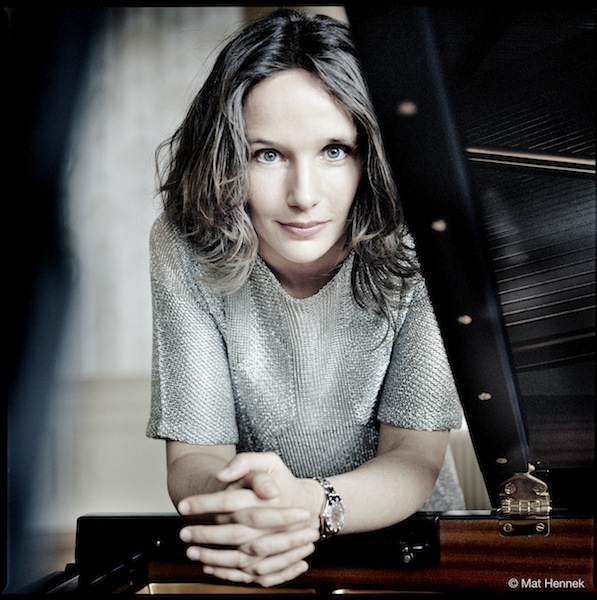Grimaud explores watery musical depths at Shriver Hall

Hélène Grimaud performed a recital Sunday night at Shriver Hall in Baltimore. Photo: Mat Hennek
Hélène Grimaud’s work at the piano tends toward refinement and elegance, more than bravura power. The French pianist was supposed to open Shriver Hall’s season in 2014 but had to withdraw because of a finger injury, to be replaced by Angela Hewitt. She finally returned to Baltimore on Sunday evening, for the first time since 2006.
The first half, drawn from the “Water” program Grimaud released on the Deutsche Grammophon label earlier this year, was reflective in the meditative and aquatic senses of the word. The eco-conscious pianist’s twee program note describes this selection of music as a “meditation on contrasting incarnations of water – gushing, trickling, raging, falling.”
Two opening pieces in slow, trickling style might seem risky for some pianists, who would rather grab an audience’s attention. Grimaud, by contrast, drew us into this world of water, taking her time on the many rolled chords of Luciano Berio’s Wasserklavier, with its allusions to earlier composers’ musical descriptions of water. In Tōru Takemitsu’s Rain Tree Sketch II, Grimaud continued her exploration of the dripping, pooling qualities of water, the work’s luscious chords a tribute to French composer Olivier Messiaen.
Grimaud’s plan then led us into music depicting the more tidal rolling of waves with Fauré’s Barcarolle No. 5, cascades of notes rippling with rhythmic freedom. Likewise, the “Almería” movement from Albéniz’s Iberia brought something of the gentle waves of the Mediterranean Sea. Grimaud’s rubato here became a bit predictable, slowing at the end of almost every measure, and heavy pedaling obscured the folksong-like cantillations in the melody.
The peak, or high tide as it were, of the concert came in two depictions of fountains flinging water into the air. Ravel’s Jeux d’Eau and its model, “Les Jeux d’eaux à la Villa d’Este” from the third year of Liszt’s Années de pèlerinage, purled off Grimaud’s fingers with delicacy. Her heavy pedaling again caused some loss of clarity, but the murky quality was equally pleasing.
Two concluding pieces, the Andante from Janáček’s In the Mists and “La cathédrale engloutie” from the first book of Debussy’s Preludes, allowed the surging energy at the middle of the half to subside just as gracefully. When Grimaud performed a longer version of this “Water” recital in New York, she reportedly played in a pool that slowly filled with shallow water. Such a gimmick is evidently not at all necessary for the program to work.
Brahms’s Second Piano Sonata after intermission was not as successful. Brahms composed three piano sonatas in 1853, and the first two were like calling cards for Brahms to play when he visited Robert and Clara Schumann in Düsseldorf. Robert Schumann was impressed, calling these sonatas “veiled symphonies” that turned the piano “into an orchestra of wailing and jubilant voices.” For his part Brahms never touched the genre again, possibly disheartened by Liszt’s transformative Piano Sonata in B Minor, published the following year and also dedicated to Robert Schumann.
Grimaud gave the booming double octaves of the first movement a lightness, preferring élan and excitement over heaviness. In the second movement Grimaud brought out the left-hand melody with a singing legato. The accompaniment lacked the fullness of color identified by Schumann, except in the large middle section where Brahms notated the music on three staves like an organ score. The Scherzo’s sweet trio section was the high point, a dreamy take on the theme that sounds like hunting horn calls. Grimaud de-emphasized the stentorian introduction of the Lisztian finale, favoring instead the rhapsodic runs in the right hand and a fast tempo for the main section.
Two Rachmaninoff encores–the Second and Third Études-Tableaux from Op. 33–suited Grimaud’s lyrical strengths better than the somewhat cursory Brahms. The focus on transparent figuration and trills, ornamenting Rachmaninoff’s sugary melodies, played again to Grimaud’s forte of doling out the sweets.
The next concert at Shriver Hall will feature pianist Inon Barnatan, clarinetist Anthony McGill, and cellist Alisa Weilerstein, 5:30 p.m. January 22. shriverconcerts.org; 410-516-7164.

Posted Dec 05, 2016 at 5:11 pm by John
What was that distracting high-pitched noise that I heard randomly during the quieter parts of the concert? Is that a newer feature of the hall, or yet another malfunctioning hearing aid of someone’s (last heard at Stephen Hough’s JCC concert)? If the latter, how is this scourge going to be prevented from happening again? Why wasn’t the culprit found and expelled?
Posted Dec 06, 2016 at 8:51 am by Laura Youens
I enjoyed reading this. Had to laugh at the word “twee.”
Posted Dec 06, 2016 at 9:06 pm by Linda Linton
The twangy, unfocused quality of the piano in the Brahms made it sound to me like a different instrument. I know the piano was repositioned slightly during the intermission. Did anyone else experience this?
Posted Dec 09, 2016 at 3:49 pm by Tom Schneider
Linda, it’s my understanding that the piano used for the Brahms was, in fact, a completely different instrument than the one used for the first half of the program. I too preferred the sound of the first instrument. A fantastic recital, nonetheless.
Posted Dec 11, 2016 at 6:59 pm by Gene
I wish I’d heard this program. The Takemitsu is a terrific piece, well worth hearing. The only time I’ve ever heard Brahms’s second sonata live was a 1982 performance in Carnegie Hall by Martha Argerich. (I am not making this up.) It was, needless to say, spectacular.
Posted Dec 12, 2016 at 11:22 am by Charles
Official word from Shriver Hall is that Grimaud did use two different pianos in this concert, one for each half, both provided by Steinway. She made the decision about these two pianos at a selection prior to the concert. She chose the two instruments based on which piano she felt was best suited for each half’s repertoire.